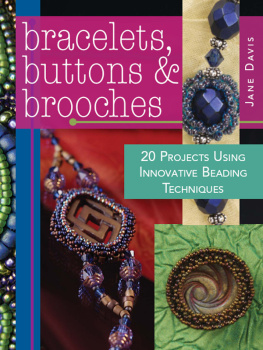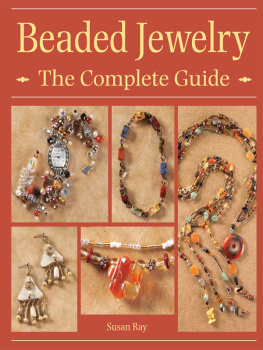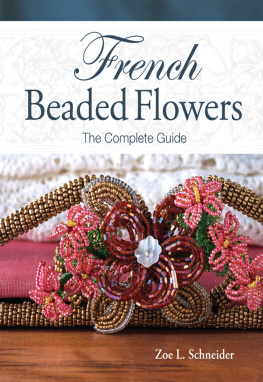The Complete Photo Guide to
BEADING


CONTENTS

THE MAGIC OF BEADS
Have you ever held a few beads in your hands and wondered at the magic and mystery of their journey, about who made them, and where they came from? Small, beautiful, intriguing, and infinitely varied, beads are so compelling that people sometimes buy them without a clue about what to do with them.
Whether you already own a stash of beads or possess none at all, this book will teachand showyou many different ways to use beads without having to acquire expensive equipment or materials. Those with no beading experience will find everything they need to begin learning techniques and creating bead jewelry and other beaded objects. Those with experience in one or more types of beading will find areas where they can expand and enhance their skills.
At the most fundamental level, there are three types of things you can do with beads: string, weave, or embroider. This book covers all three categories. Within each category, you will find a variety of techniques shown through a broad range of projects. Youll learn all the basics, including design ideas, techniques, and tips for creating various objects with beadssome to wear, some to give away, some to decorate your home, and some just for fun.
THE SAGA OF BEADS

Some anthropologists believe that beads are humans earliest artifacts, predating tools and vessels. Whatever the exact time line, we know that early humans pierced natural materials like bone and shell, stringing them on grass or reeds to make personal adornments.
In nearly every culture and every land since the very beginning, people have found ways to make and use beads. From primitive cultures to the ruling classes, from earliest humans to modern times, beads are nearly ubiquitous.

In the past few centuries, beading was considered a craft. Although some types of beading required great skill, such as the beaded handbags created by Victorian women, and some crafters of beaded jewelry attained position and status, beads and beading were largely ignored in the art world. However, in recent years, many people have begun to view beading as an art as well as a craft. Increasing numbers of beaders are considered artists, their beadwork recognized by collectors, museums, and galleries as an important art form.

Small, easily portable, often used in barter or trade, beads are given value based on their age, uniqueness, and the material from which they are made. Since most types of beads are durable, they can last for hundreds of years, passing from hand to hand, being repurposed and relocated by each owner. The history and future of beads (and beaded objects) are two of the things we find so compelling about beads. And the future is changing.
A beading renaissance began in the late 1980s, and included all types of beading. In addition to beading itself, artisans took up bead making, creating lampwork, blown glass, and polymer clay beads. As beading and bead making gained popularity and markets, the need for gatherings, such as international bead conferences, also expanded.
Soon bead collectors, makers, and artists developed an Internet presence, developing websites, creating blogs, and forming interest groups. Today, a strong sense of being connected around the world can be gained through beads and beading. Picture a string of beads wrapped around the earth many times in every direction, including people in every country, all of them united by their common affection for beads and the art and craft of beading, all of them experiencing a passion that returns them to the very roots of humankinds earliest and most consistent form of adornment. Welcome to the wonderful world of beads!

ALL ABOUT BEADS
The variety of beads available to a beader is astonishing!
Ranging in size from itty-bitty, like a grain of salt, to as big is your fist, beads are created from hundreds of different materials, such as glass, stones, metal, plastic, porcelain, bone, felted wool, and even crushed rose petals. The texture or finish can range from rough to smooth, frosted to glossy, soft to hard, transparent to opaque. Common shapes of beads include round, oval, cubes, tubular, bicone, and disks. Beads are also formed in special shapes such as hearts, flowers, and leaves.
For a reasonable cost, you can quickly acquire quite a stash, stimulating and exciting, calling you to create beaded objects, partly just for the pleasure of doing it. Bead shops are found in most towns and cities; plus there are countless online sources for new and vintage beads. Some resources are listed on .
Glass Beads
Glass is so versatile and is available in so many colors that it has long been a favorite material for making beads. Researchers believe the earliest glass beads were made in Egypt and Mesopotamia and may be dated as early as 3500 BCE.
Today glass beads are classified by the method used to make them. Manufactured worldwide, glass beads are made by huge companies, small businesses, and by artists working in home-based studios.
Lampwork Beads
Lampwork beads (also called flame-worked or wound beads) are made by holding a slender rod of glass in the flame of a torch until the glass at the tip of the rod becomes molten. The lampworker holds a metal rod in the other hand, winding the molten glass around it to create each bead. Beads may be shaped in half-molds or with paddles. When complete, beads are cooled slowly (annealed) to prevent cracks from developing.


Blown Glass Beads
To create blown glass beads, the maker takes a gather of molten glass from a furnace on the end of a long metal pipe and then blows into the pipe to force air into the glass at the other end, forming a bubble. The glass blower then reheats the glass, attaches a second pipe to the other side of the bubble, and pulls the pipes in opposite directions to create a tube. When the tube is the desired diameter, the glass is cooled, eventually cut into tubular beads, and polished to smooth the cut ends. These types of beads are also called cane glass beads.
Grinding certain areas of the tube produces faceted blown glass beads. Cutting the tubes into thin slices produces disks. Layering different colors of glass over the original gather before pulling the tube yields multi-colored beads. Blowing the molten glass into a mold creates hollow, shaped beads.





![Danielson Ethan - The beaders bible: [a comprehensive guide to beading techniques]](/uploads/posts/book/197332/thumbs/danielson-ethan-the-beader-s-bible-a.jpg)









